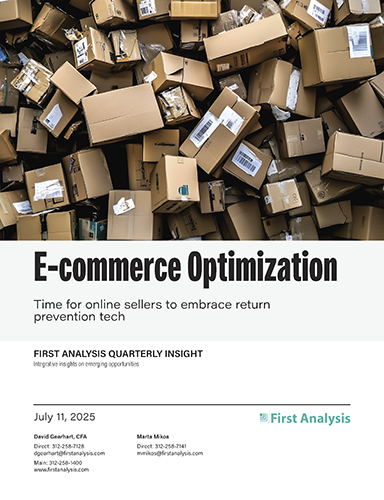Quarterly insights: E-commerce optimization
Time for online sellers to embrace return prevention tech

Online return rates are significantly higher than traditional retail return rates, with 30% of online orders being returned compared to just 9% for physical stores.
Returns are a significant financial burden for online sellers. They reduce revenue and increase costs, eroding margins. In fact, 80% of retailers categorize return-related costs as “significant to severe.” Since e-commerce has been growing 7.5% annually, the direct and indirect costs of returns for online sellers will likely increase at a similar pace.
We believe it is possible for online sellers to use return prevention technology to drive e-commerce return rates down to match traditional retail rates, moving from 3:1 to 1:1. We highlight several solution types we believe are most relevant to preventing returns and profile a promising company in each category.
TABLE OF CONTENTS
- Accepting returns has become the standard, but it’s expensive
- Returns are a bigger issue for e-commerce
- What gets returned and where?
- Root causes of returns
- How e-commerce returns are handled today
- Returns are costly
- Tech can change e-commerce return dynamics and reduce costs
- Notable return prevention technologies
- Attributes of anticipated winners
- Parting thoughts
- E-commerce optimization index ends with strong gain, but well below peak
- E-commerce M&A: Notable transactions include mParticle, Appriss Retail and OfferFit
- E-commerce private placements: Notable transactions include Intelligems, Gierd, VOC.AI and Cart.com
Accepting returns has become the standard, but it’s expensive
Consumers have come to expect online and in-store sellers to offer reasonable return policies. Such policies – which clearly outline what items are eligible, return timelines, item condition requirements, and processes – have long been the industry standard for sellers. The option to return purchases is a key consideration in consumers’ purchase decisions. It reduces pressure at the point of sale and gives buyers greater confidence by lowering their risk from making poor or unsuitable purchase decisions. In fact, many consumers won’t buy from a seller that doesn’t offer returns, instead choosing one of the many competitors that do. Over 60% of consumers check return policies before buying, and rigid or inconvenient policies can quickly drive them elsewhere. As a result, offering returns has become essential for sellers to remain competitive.
But offering returns is expensive. Accepting returns involves costs for processing returns, refurbishing damaged returns, restocking returned products, and disposing of unsellable returns. These tasks require labor, transportation and space. And sellers generally can’t recoup their costs by charging return shipping and restocking fees: Free returns have become standard, so such fees simply drive consumers to competitors offering free returns. According to PowerReviews, 76% of consumers prioritize free returns. A Klarna survey found 70% of online consumers would stop buying from retailers that ceased offering free returns.
Returns are a bigger issue for e-commerce
Returns are a much bigger issue for online sellers than for physical stores. Online return rates are significantly higher than traditional retail return rates, with 30% of online orders on average across all product categories being returned compared to just 9% for physical stores, about a 3 to 1 ratio. In dollar terms, $247 billion of the $1.4 trillion in online sales in 2023 were returned, compared to $371 billion of $3.7 trillion sales for physical stores. That data may even understate the gap, since many retailers do not disclose return data. Since e-commerce has been growing 7.5% annually, the returns issue for online sellers will likely only become more pressing: The more goods that are purchased online, the more that will be returned. Unless online sellers can sufficiently reduce their return rates or their cost of processing returns, they’ll need to increase their investment in physical capacity, people and technology to keep pace with the increase in returns that comes with increased sales volume.
A number of factors account for online sellers’ higher return rates. First, while the selection of goods online sellers can offer is not limited by physical retail space, enabling them to offer a much larger selection, their customers have more limited ability to experience the products directly, such as by feeling or trying on clothing before they buy. Upon delivery, they often discover products don’t look, feel, fit or perform as anticipated. Second, products purchased online are subject to damage during delivery, unlike products buyers take home from physical stores. Third, online sellers may ship the wrong product or ship products with parts missing; an in-store buyer is less likely to walk out with the wrong product or a product missing parts.

Request full report
To access the full report, please provide your contact information in the form below. Thank you for your interest in First Analysis research.
